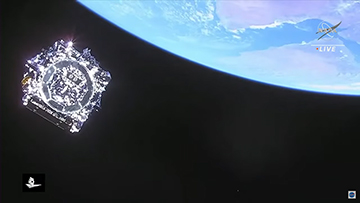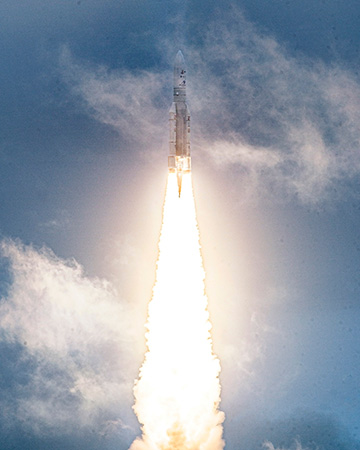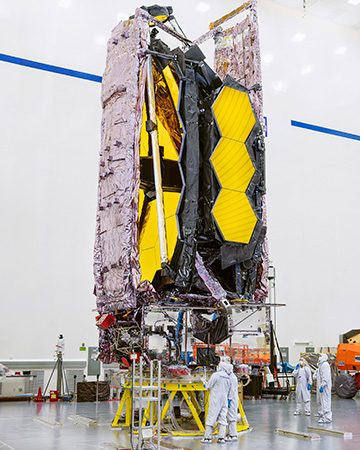
Instant classic. An already-iconic image, snapped from a launch-vehicle camera, shows the James Webb Space Telescope shortly after separation from the launch vehicle. [Image: From NASA video feed]
That noise you heard at around 12:50 UTC on 25 December was the sound of thousands of astronomers, optical scientists, spacecraft designers, engineers, administrators and many others exhaling.
That was the long-awaited moment when the James Webb Space Telescope separated from its launch vehicle, unfurled its array of solar panels, and began its long solo voyage to the L2 Lagrange point, nearly 1.5 million km (1 million miles) away from Earth. The deployment of the solar panels meant that the spacecraft was now generating its own power, and that Webb’s mission of cosmic exploration had truly begun.
Having enjoyed a few moments of inspiration, Webb watchers can now inhale deeply and prepare to hold their breaths for at least another few weeks. Between now and around 13 days after launch, while en route to L2, the spacecraft must undertake a byzantine set of deployment steps to seal communications with Earth, secure its sensitive optical instruments from thermal swings and move its huge, 6.5-m (21-ft) primary mirror and smaller secondary mirror into place.
After that will come around 10 days of calibration and tweaking of its 18 individual primary-mirror segments before Webb’s insertion into orbit around L2. And, once in orbit, another five months of optical alignment and instrument calibration will need to happen before the observatory starts its data collection project in earnest.
Decades in the making
If all goes according to plan, few are likely to begrudge Webb the additional few months of commissioning time—since, as has been widely reported, the moment of first light for the observatory will have literally been decades in the making.
The huge and ambitious new infrared observatory promises a feast of new science. Among the expected goodies from the telescope will be previously unavailable views back to just after the proverbial beginning of time; new insights on star formation; glimpses of the atmospheres of distant exoplanets. But the spacecraft itself—perhaps the most complicated piece of engineering that the US space agency, NASA, has ever tried to put aloft—has been plagued by repeated development delays, and seen its total cost balloon to billions of US dollars more than originally envisioned.
Flawless launch

Flawless. A highly professional launch, in an Ariane 5 vehicle provided by the European Space Agency, got Webb’s journey off to a promising start. [Image: NASA/Chris Gunn]
Patience with the delay was rewarded on Christmas morning in Kourou, French Guiana, with the spacecraft’s flawless launch and ride into space atop an Ariane 5 launch vehicle. Managed by the European Space Agency (ESA) and the French firm Arianespace and live-streamed by NASA, the launch was an impressive—indeed, inspiring—display of professionalism and grace under pressure.
Even so, the control center erupted in cheers and relief when the spacecraft separated from the launch vehicle and began its solo voyage to the gravitationally neutral L2 point. (L2, which has also hosted the WMAP and Planck observatories, was chosen for Webb in large part to help protect the sensitive infrared instruments from solar heat and thermal swings.)
In addition to providing the launch vehicle and managing the launch, ESA is responsible for two of the observatory’s onboard instruments, the Near-Infrared Spectrograph and the Mid-Infrared Optics Assembly. Another international partner, the Canadian Space Agency (CSA), provided the Fine-Guidance Sensor/Near-Infrared Imager and Slitless Spectrograph. NASA has overall responsibility for the Webb mission, including the wrangling of the array of private contractors that delivered the final, integrated product. (The full list of partners and contributors worldwide runs to more than 300 organization names.)
Nail-biting month ahead
As successful as the launch was, it marked only the beginning of roughly a month of nail-biting before the spacecraft is safely inserted into its halo orbit around L2. Much has been made of the 344 “single points of failure” in the spacecraft’s deployment process. As the phrase implies, an unsuccessful outcome in any of these steps could, in principle, doom the entire mission.
In a blog post last August, NASA associate administrator Thomas Zurbuchen explained that, for many space missions, the majority of risk is “retired” once the spacecraft has been launched. But for some—such as the 2020 Perseverance Rover mission, and now the Webb telescope—most of the risk is concentrated into the period after launch. NASA has acknowledged that the process of unpacking and assembling the Webb telescope and nestling it into orbit around L2 constitutes “the most difficult and complex deployment sequence ever attempted in space.”
“Those who are not worried or even terrified about this,” Zurbuchen wrote with remarkable candor, “are not understanding what we are trying to do.”
The road to L2
Fortunately, for those kept awake by such things, NASA has provided an oddly mesmerizing “Where Is Webb” online resource that tracks the spacecraft’s progress en route to L2, and the status of various deployment steps.
As of this writing, Webb had already covered more 17% of the 1.5-million-km distance to L2, according to the NASA timeline, and had hit a number of important early milestones. The latter include the deployment of the solar array—an automated step that actually happened a few minutes ahead of schedule—and the first of three mid-course correction burns by the spacecraft’s onboard propulsion system, to adjust its trajectory, which started around 12.5 hours after launch and lasted 65 minutes. Another key milestone, the automated deployment of the craft’s high-rate antenna, to facilitate communication with Earth, was expected to happen roughly a day after launch.

Bundled up. A photo from September, shortly before the Webb telescope began its journey from California to the launch site in French Guiana, shows the spacecraft’s mirrors and sunshield both compactly folded for launch. [Image: NASA/Chris Gunn]
After that, the next high point, beginning three days after launch, will be the nerve-wracking, week-long process of releasing, unfurling and tensioning the observatory’s five-layer, tennis-court-sized sunshield—a system that was responsible for several of the delays that plagued the overall project timeline. The sunshield will help keep the spacecraft’s infrared optical instruments at operating temperatures below 50 K. It was secured for launch and early flight by 107 separate “non-explosive actuators”—individual retaining pins, each of which must release properly for the sunshield to be properly deployed.
Assuming sunshield deployment is successful, starting at around 10 days after launch, the process of deploying the observatory’s mirrors—the very visible and familiar “business end” of the Webb telescope—will commence. The secondary mirror will swing down into place on day 10. The massive 6.5-m primary mirror—the largest ever launched into space—will take shape on days 12 and 13, as two wings folded back for launch swing into place like giant hinged doors.
At that point, the telescope will be fully deployed—but not yet ready for prime time. Between 15 and 24 days after launch, the 18 hexagonal segments of the primary mirror will be tweaked by a series of actuators into proper configuration to allow them to see as a single, 6-5-m mirror. At day 29, the spacecraft will make a final midcourse correction burn to insert it into orbit around L2. The telescope and instruments will then spend several weeks cooling off behind the sunshield—and another five months or so being adjusted, aligned and calibrated for the telescope’s ten-year mission.
